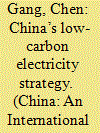|
|
|
Sort Order |
|
|
|
Items / Page
|
|
|
|
|
|
|
| Srl | Item |
| 1 |
ID:
146674


|
|
|
|
|
| Contents |
With a carbon-constrained new normal that emissions of greenhouse gases can no longer be assumed to be costless, non-fossil fuels including hydro, nuclear, wind and solar power have witnessed fast growth in both production and consumption in China. In promoting the production of different low-carbon alternatives, the Chinese government has been adjusting its policy prioritisation from time to time in targeted growth scopes, subsidy amount, on-grid tariffs and other financial incentives for various low-carbon power sectors. China’s Five-Year Plans have been playing a vital role in engendering fierce competition within the low-carbon energy sector. Other variables, like adjustment of electricity tariffs, inherent geographical and meteorological advantages related to certain types of power generation, domestic supporting industries, technological competitiveness and environmental concerns, have also helped to reshape the low-carbon power market.
|
|
|
|
|
|
|
|
|
|
|
|
|
|
|
|
| 2 |
ID:
148206


|
|
|
|
|
| Summary/Abstract |
International collaborations embed American scientists and students in vibrant, globally collaborative networks that strengthen the U.S. science, technology, and innovation (STI) enterprise, while benefiting both America and the world. Because such benefits have not been systematically explored in the United States, we present a framework for organizing and enumerating them, with national-level examples provided to illustrate scientific, economic, health, national security, educational, societal, and diplomacy and development advantages that can result from international STI collaborations.
|
|
|
|
|
|
|
|
|
|
|
|
|
|
|
|
|
|
|
|
|